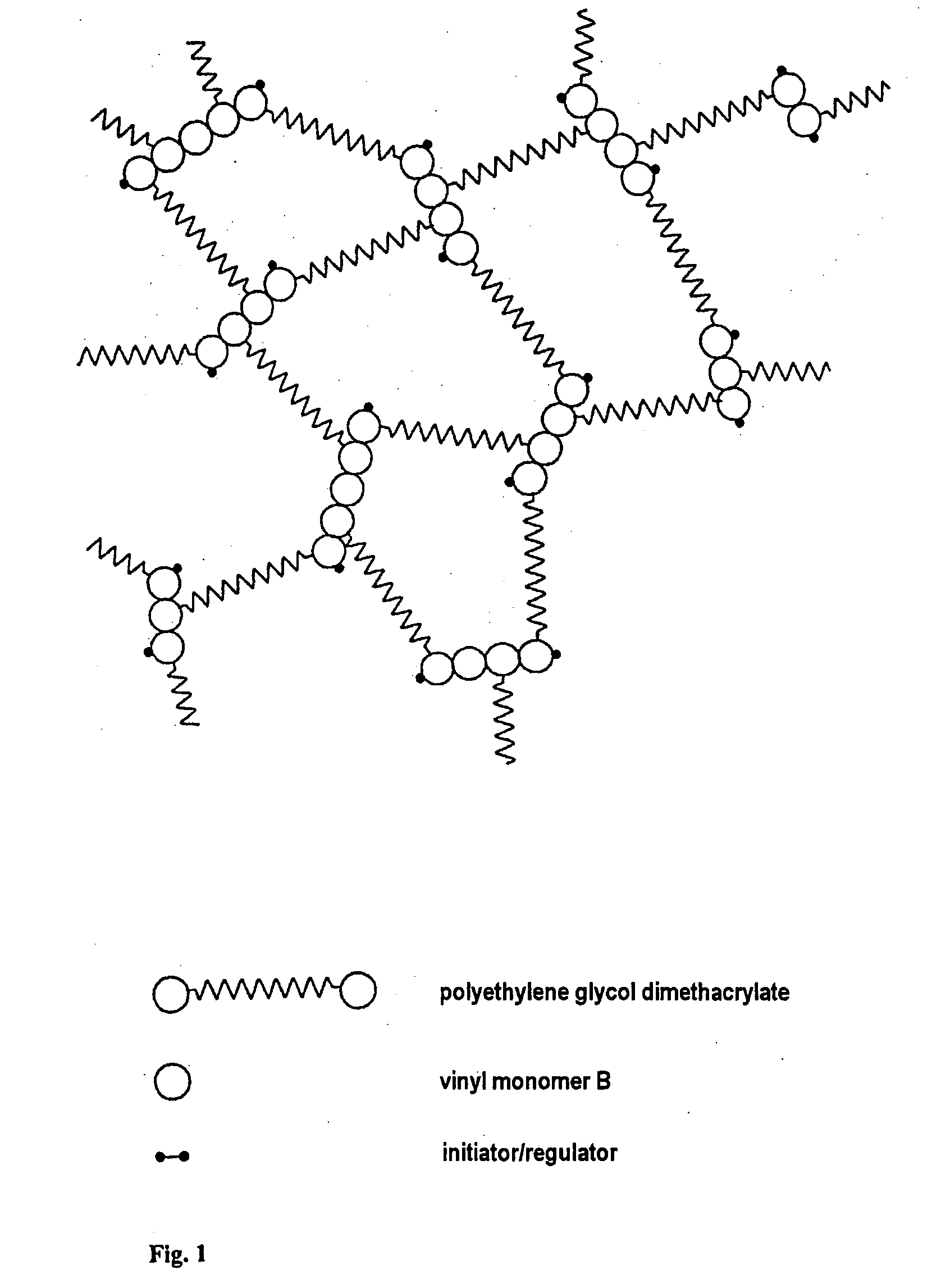Hydrogel
a technology of hydrogels and gels, applied in the field of hydrogels, can solve the problems of high the stiffness of the polymethacrylate chain is a hindrance in many applications, and the protein migration in the polymethacrylate network is much slower, so as to achieve excellent mechanical and optical properties, increase the refractive index, and the effect of high mobility of the polyethylene glycol chain
- Summary
- Abstract
- Description
- Claims
- Application Information
AI Technical Summary
Benefits of technology
Problems solved by technology
Method used
Image
Examples
example 1
Water / DMA=8.7 DMA / Regulator=3.0 0.5n limit: 11.5 Polymerization about 85° C. below the Cloud Point
[0064] A mixture of 1.760 g of Plex 6874-O® from Degussa / Röhm Methacrylates (60% strength solution of PEG 1000 DMA in water)(=1.056 g of polyethylene glycol dimethacrylate (n=23) (0.9 mmol) in 0.704 g of water), 0.021 g of ammonium peroxodisulfate and 0.033 g of 3-mercapto-1,2-propanediol (0.3 mmol) is admixed at about 5° C. with 0.028 g of N,N,N,N-tetramethylethylenediamine, degassed and polymerized under argon at 5° C. Demolding gives a crystal-clear, bright, elastic hydrogel (light transmittance >90%, haze <10%) suitable for optical applications and as an electrophoresis gel.
example 2
Water / DMA=3.9 DMA / Regulator=1.9 0.5n Limit: 12.5 Polymerization about 80° C. below the Cloud Point
[0065] A solution of 2.0 g of polyethylene glycol dimethacrylate (n about 25) (1.6 mmol), 0.026 g of ammonium peroxodisulfate and 0.091 g of 3-mercapto-1,2-propanediol (0.84 mmol) in 7.825 g of water is mixed at about 5° C. with 0.022 g of N,N,N,N-tetramethylethylenediamine and the mixture is degassed and polymerized at 5-10° C. under argon as inert gas. This produces a colorless, crystal-clear hydrogel which exhibits good strength and elasticity. This hydrogel has good cutability and is suitable as an electrophoresis gel and for optical applications. It has a light transmittance >90% and haze <10%.
example 3
Water / DMA=4.6 0.5n Limit: 11.5 Polymerization with a Redox System about 70° C. below the Cloud Point
[0066] A mixture of 3.0 g of Plex 6874-O® from Degussa / Röhm Methacrylates (60% strength solution of PEG 1000 DMA in water)(=1.8 g of polyethylene glycol dimethacrylate (n=23) (1.54 mmol) in 1.2 g of water), 3.0 g of a 1% strength solution of potassium peroxodisulfate in water, 1.0 g of a 1% strength solution of sodium hydrogensulfite in water and 3.0 g of water is admixed with 40 μl of a solution of 100 ppm of iron (II) sulfate in water and 20 μl of 1 N sulfuric acid and the mixture is degassed and polymerized under argon at about 20° C. Polymerization commences immediately after degassing. This produces a clear, stable hydrogel.
PUM
| Property | Measurement | Unit |
|---|---|---|
| Temperature | aaaaa | aaaaa |
| Fraction | aaaaa | aaaaa |
| Fraction | aaaaa | aaaaa |
Abstract
Description
Claims
Application Information
 Login to View More
Login to View More - R&D
- Intellectual Property
- Life Sciences
- Materials
- Tech Scout
- Unparalleled Data Quality
- Higher Quality Content
- 60% Fewer Hallucinations
Browse by: Latest US Patents, China's latest patents, Technical Efficacy Thesaurus, Application Domain, Technology Topic, Popular Technical Reports.
© 2025 PatSnap. All rights reserved.Legal|Privacy policy|Modern Slavery Act Transparency Statement|Sitemap|About US| Contact US: help@patsnap.com

